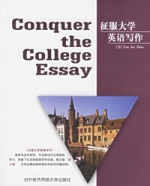內容簡介

本書在教授修辭寫作範式的同時強調了學習不同問題的功能,有效地緩解了學生對於英語寫作課的憂慮,增強了學生表達自我的願望,並且切切實實學習了修辭寫作,打下了紮實的英語寫作基礎。本書絕非為應試而作。不過經過行之有效的學習,具備了紮實的英語寫作功底,既已獲“漁之道”,又何必懼怕各種考試中的寫作題目呢?
編輯推薦
本書把傳統的修辭寫作範式按其主要功能大致歸納為三大類:分享寫作、認識寫作和探研寫作,提出大學階段的英語寫作集中攻克各類旨在闡述、描寫或解釋某人或某事的發生、發展、結果,或特徵、狀態、功能等的說明文體。分享寫作的目的是與讀者分享個人經驗、感想或信息,通過敘述、描寫、舉例等修辭寫作方法讓學生學會如何選題,如何設定敘述細節,如何確定敘事人的角度,如何把握清楚的敘事脈絡,等等。認識寫作目的是分析認識各種主題。通過範文讓學生了解如何提出主題,如何分析闡述因果,如何分析比較異同,如何歸納與分類,如何論證和闡明觀點,等等。在習作這類文體的過程中,循序漸進地演示修辭寫作方法和特別注重培養學生的批判性思維能力在教材中得到了有效的結合。探研寫作講解了怎樣作文獻批評,怎樣作調查研究,怎樣從圖書館或網際網路查詢資料,怎樣立題,怎樣論證,怎樣引證等等,一步步有效地引導學生學習學術論文的寫作。
本書在教授修辭寫作範式的同時強調了學習不同文體的功能,強調了學生完成寫作行為的整個過程,有效地緩解了學生對於英語寫作課的憂慮,增強了學生表達自我的願望,並且切切實實學習了修辭寫作,打下了紮實的英語寫作基礎。
目錄
PartI:Laying a Strong Foundation for Writing: Composing Stages and Wrriting Standards
第一部分寫作基礎:寫作步驟和寫作標準
1.Introduction
1.1 The Importance of Essay Writing
1.2 Levels of(American)College Student Essays
1.3 Common College Essay Assignments
1.4 The Aim and Organization of the Book
2.How to Generate Ideas:Planning
2.1 Find a Good Topic
2.2 Understand a Given Topic
2.3 Generate Ideas for a Topic
2.4 Get a Plan for Organization
2.5 Use Criteria to Form Strong Main Points
3.How to Organize Ideas:Drafting
3.1 Drafting versus Planning
3.2 Outlining before Drafting
3.3 Writing the Introduction
3.4 Writing Body Paragraphs
3.5 Writing the Conclusion
4.How to Polish Ideas:Revising
4.1 Be Willing to Make Changes
4.2 Understand Writing Standards:Unity,Coherence and Support
4.3 Revise for Better Focus and Organization
4.4 Revise for Better Coherence
4.5 Revise for Better Support
4.6 Revise for Grammatical Correctness
PartⅡ:wrua,~to Share
第二部分分享寫作
5.Sharing Experiences:Narrating
5.1 HOW to Plan for a Narrative
5.2 How to Organize a Narrative:Narrative Structure
5.3 How to Maintain a Clear Narrative Sequence
5.4 How to Establish a Credible Narrator and Point Of View
5.5 How to Tell a Compelling Story
Student Essay TheKiss
Samuef HScudder“Take This Fish and Look at It”
Edgar Alan Poe TheTell—Tale Heart
6.Sharing Images and Impressions:Describing
6.1 Using Objective and Subjective Description
6.2 Describing with Sensory Details
6.3 Describing with Figurative Language
6.4 Creating Physical Image and Character Image
6.5 Creating Images with Dialogue and Example
William Spooner Donald Will SomeonePleasehiccupMy Pat?
Stephen Leacock My Discovery ofEngland
7.Sharing Examples:Illustrating
7.1 Consider This Example
7.2 Illustrate a Point with Specific Examples
7.3 Illustrate a Point with Typical Examples
7.4 Use Both Types of Examples
John Leo NoBooks,Please;We’re Students
Samuel Johnson On the Art ofAdvertising
Stephen King Ever Et RawMeat?
8.Sharing Ideas:Informing
8.1 Topics for an Informative Essay
8.2 How to Plan for an Informational Essay
8.3 How to Organize an Informative Essay
8.4 How to Make an Essay(More)Informative
Student Essay Attaining Success inCollege
Sherry Sweetnam How to Organize Your Thoughts for BetterCommunication
Jeanine Barone Surprising SuperFoods
PartⅢ:Writing to Understand
第三部分認識寫作
PartIV:Writiong to Explore
第四部分 探研寫作
附錄
參考書目
